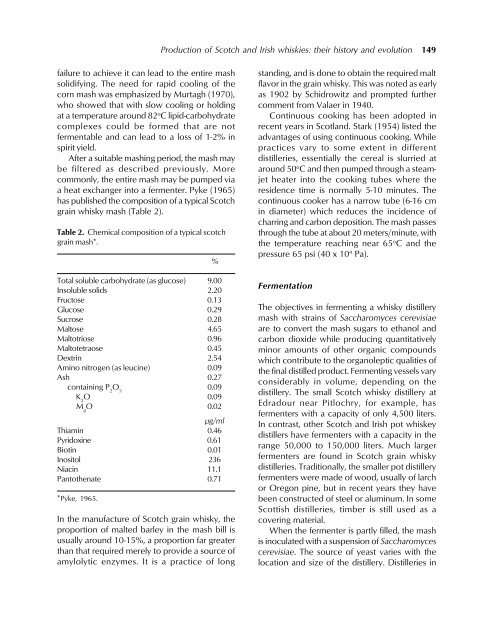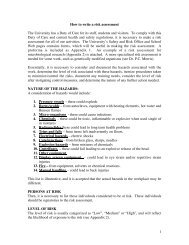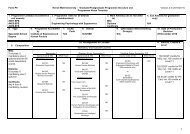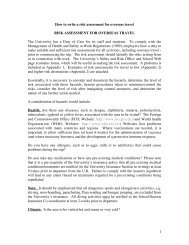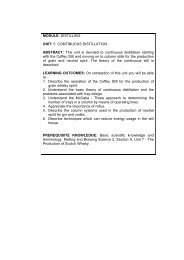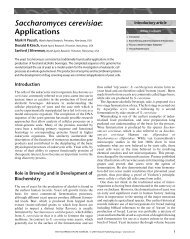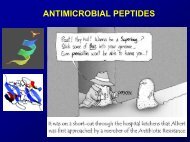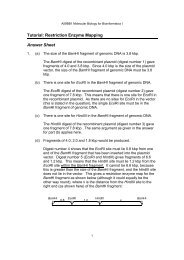Chapter 11 Production of Scotch and Irish whiskies: their history and ...
Chapter 11 Production of Scotch and Irish whiskies: their history and ...
Chapter 11 Production of Scotch and Irish whiskies: their history and ...
Create successful ePaper yourself
Turn your PDF publications into a flip-book with our unique Google optimized e-Paper software.
<strong>Production</strong> <strong>of</strong> <strong>Scotch</strong> <strong>and</strong> <strong>Irish</strong> <strong>whiskies</strong>: <strong>their</strong> <strong>history</strong> <strong>and</strong> evolution 149failure to achieve it can lead to the entire mashsolidifying. The need for rapid cooling <strong>of</strong> thecorn mash was emphasized by Murtagh (1970),who showed that with slow cooling or holdingat a temperature around 82 o C lipid-carbohydratecomplexes could be formed that are notfermentable <strong>and</strong> can lead to a loss <strong>of</strong> 1-2% inspirit yield.After a suitable mashing period, the mash maybe filtered as described previously. Morecommonly, the entire mash may be pumped viaa heat exchanger into a fermenter. Pyke (1965)has published the composition <strong>of</strong> a typical <strong>Scotch</strong>grain whisky mash (Table 2).Table 2. Chemical composition <strong>of</strong> a typical scotchgrain mash*.Total soluble carbohydrate (as glucose) 9.00Insoluble solids 2.20Fructose 0.13Glucose 0.29Sucrose 0.28Maltose 4.65Maltotriose 0.96Maltotetraose 0.45Dextrin 2.54Amino nitrogen (as leucine) 0.09Ash 0.27containing P 2O 50.09K 2O 0.09M gO 0.02µg/mlThiamin 0.46Pyridoxine 0.61Biotin 0.01Inositol 236Niacin <strong>11</strong>.1Pantothenate 0.71*Pyke, 1965.In the manufacture <strong>of</strong> <strong>Scotch</strong> grain whisky, theproportion <strong>of</strong> malted barley in the mash bill isusually around 10-15%, a proportion far greaterthan that required merely to provide a source <strong>of</strong>amylolytic enzymes. It is a practice <strong>of</strong> long%st<strong>and</strong>ing, <strong>and</strong> is done to obtain the required maltflavor in the grain whisky. This was noted as earlyas 1902 by Schidrowitz <strong>and</strong> prompted furthercomment from Valaer in 1940.Continuous cooking has been adopted inrecent years in Scotl<strong>and</strong>. Stark (1954) listed theadvantages <strong>of</strong> using continuous cooking. Whilepractices vary to some extent in differentdistilleries, essentially the cereal is slurried ataround 50 o C <strong>and</strong> then pumped through a steamjetheater into the cooking tubes where theresidence time is normally 5-10 minutes. Thecontinuous cooker has a narrow tube (6-16 cmin diameter) which reduces the incidence <strong>of</strong>charring <strong>and</strong> carbon deposition. The mash passesthrough the tube at about 20 meters/minute, withthe temperature reaching near 65 o C <strong>and</strong> thepressure 65 psi (40 x 10 4 Pa).FermentationThe objectives in fermenting a whisky distillerymash with strains <strong>of</strong> Saccharomyces cerevisiaeare to convert the mash sugars to ethanol <strong>and</strong>carbon dioxide while producing quantitativelyminor amounts <strong>of</strong> other organic compoundswhich contribute to the organoleptic qualities <strong>of</strong>the final distilled product. Fermenting vessels varyconsiderably in volume, depending on thedistillery. The small <strong>Scotch</strong> whisky distillery atEdradour near Pitlochry, for example, hasfermenters with a capacity <strong>of</strong> only 4,500 liters.In contrast, other <strong>Scotch</strong> <strong>and</strong> <strong>Irish</strong> pot whiskeydistillers have fermenters with a capacity in therange 50,000 to 150,000 liters. Much largerfermenters are found in <strong>Scotch</strong> grain whiskydistilleries. Traditionally, the smaller pot distilleryfermenters were made <strong>of</strong> wood, usually <strong>of</strong> larchor Oregon pine, but in recent years they havebeen constructed <strong>of</strong> steel or aluminum. In someScottish distilleries, timber is still used as acovering material.When the fermenter is partly filled, the mashis inoculated with a suspension <strong>of</strong> Saccharomycescerevisiae. The source <strong>of</strong> yeast varies with thelocation <strong>and</strong> size <strong>of</strong> the distillery. Distilleries in


